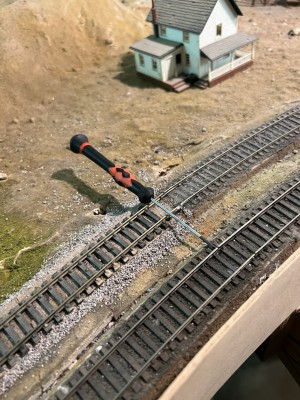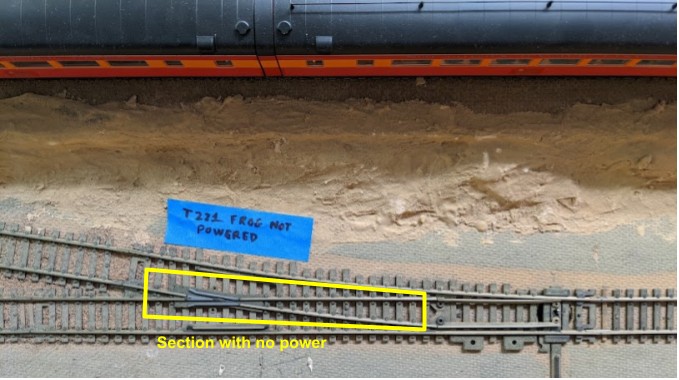The Randall Museum in San Francisco hosts a large HO-scale model railroad. Created by the Golden Gate Model Railroad Club starting in 1961, the layout was donated to the Museum in 2015. Since then I have started automatizing trains running on the layout. I am also the model railroad maintainer. This blog describes various updates on the Randall Museum Model Railroad and I maintain a separate tech blog for all my electronics & software not directly related to Randall.
2022-03-06 - Non-Maintenance Update
Category RandallWe have two spots on the layout where we have experienced episodic dead spots -- loss of track power that seems to fix itself. I suspect some rail or solder contact that works or doesn’t work based on the temperature and humidity. I’ve fixed a couple of these and each time I need to experience the dead spot to figure where it originated from. It’s hard to fix something when that thing just plain works.
Yesterday, a new such spot appeared, at block B100 between Lodi and Fairfield. Allen was able to work around by bridging the gap between B90 and B100 using a screwdriver, thus powering B100 from B90:
I’m a big fan of such creative workaround to keep running.
We closely examined the track today, and identified the block boundaries. Unfortunately there was no dead spot today, the track was working fine, and we found no culprit to this issue. There’s a track feed a couple feet before, and the solder joints seem sturdy and nothing breaks when the track is flexed or the wires are jiggled around -- a proven rigorous scientific approach to identify such issues.
We also examined some other spots where we have had engines stop-and-go on specific turnouts. I posit some have to be due to resistance from the powered frog contacts on the switch machines. However measuring a few spots revealed nothing useful. It did not help that today engines were not hesitating on these spots either.
It’s quite annoying when everything works, ironic, isn’t it?
Later, we looked at a known issue with engines losing power when crossing turnout T221. Looking at it and testing it with the voltmeter, it became quite obvious:
The entire frog is unpowered on this turnout -- everything in the middle “X” part till the two round pivot joints. The closure rails (the ones that move) seem powered only by contact with the stock rails. There’s also no sign of any power pick up anywhere on this turnout. It’s really entirely unpowered. That means most trains stop on this turnout unless they have multiple units, or long wheelbase engines such as these long SD70s.
The turnout looks to me to be an Atlas turnout, due to the typical two tabs next to the throw bar. On Atlas turnouts, these two tabs with their little middle hole are used to attach a side twin-coil turnout machine.
If we wanted to fix this, we would have to power the frog and the inner closure rails. To do that, the twin-coil switch machine under the layout already has the contacts that can control the frog power but we’d need to pick up power from the stock rails, and somehow solder the “outgoing” power feed to the frog. Many turnouts have solder points on the underside to create such connections, and obviously here we’d have to do it from the top. It’s some work but it’s definitely doable.
A quick search on powering frog on Atlas turnouts indicates the frog is “pot metal” and won’t take any solder, however there are holes next to it just for that purpose and one would make contact by using a “2-56 screw” in there. An indeed there are two holes right next to that frog:



